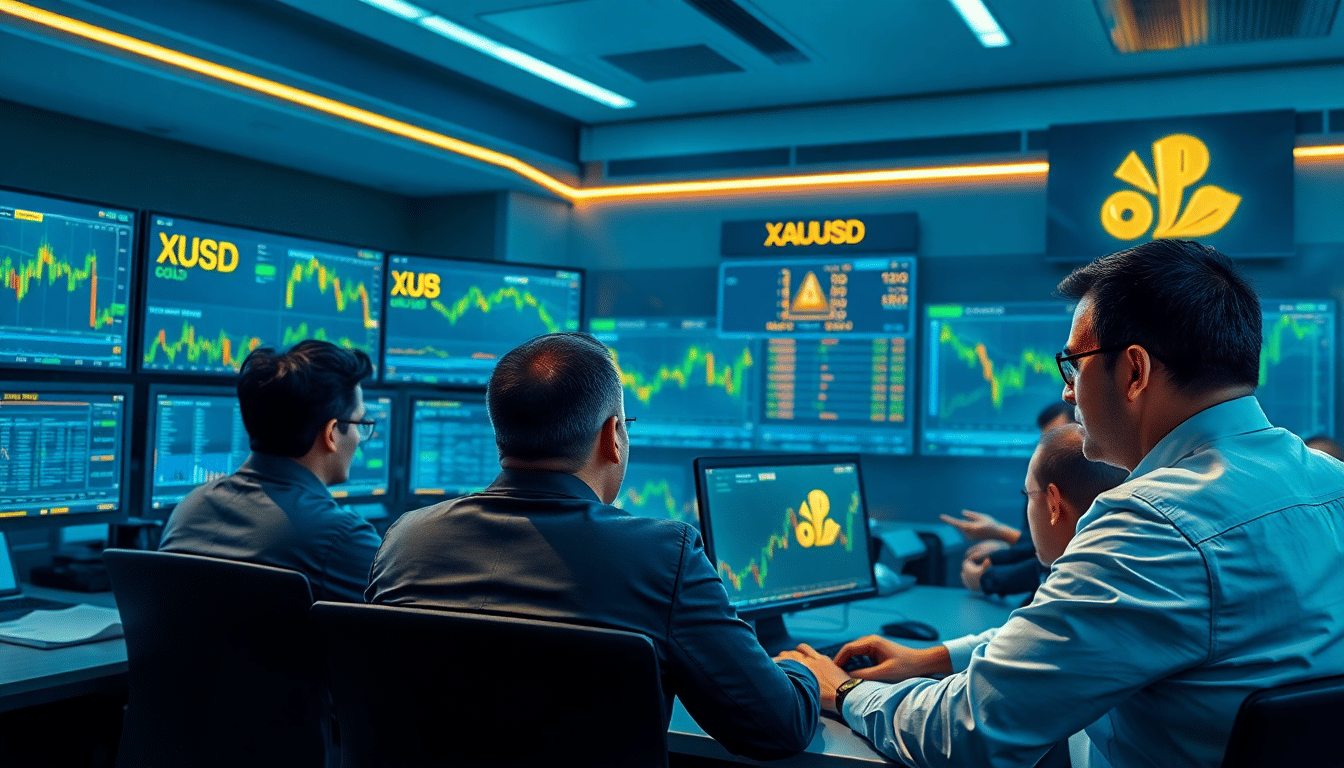The XAUUSD market, representing the trading pair of gold (XAU) against the US dollar (USD), is one of the most actively traded commodities in the world. Gold has long been regarded as a safe haven asset, particularly during times of economic uncertainty or geopolitical tension. Investors flock to gold as a means of preserving wealth, which often leads to increased demand and, consequently, price fluctuations.
Understanding the dynamics of this market is crucial for traders looking to capitalise on its movements.
This continuous trading environment can lead to significant price volatility, influenced by a myriad of factors including economic data releases, central bank policies, and global events.
As such, traders must remain vigilant and informed about both macroeconomic indicators and market sentiment to make educated trading decisions. The interplay between gold and the US dollar is particularly noteworthy; typically, when the dollar strengthens, gold prices may decline, and vice versa. This inverse relationship is a fundamental aspect of trading XAUUSD that every trader should grasp.
Summary
- XAUUSD is the symbol for the price of one ounce of gold in terms of US dollars, and it is a popular trading instrument in the forex market.
- Technical analysis and charting tools such as moving averages, Bollinger bands, and Fibonacci retracement levels can be used to identify trends and potential entry and exit points in XAUUSD trading.
- Fundamental analysis, including market news and economic indicators, can have a significant impact on the price of gold and the XAUUSD market.
- Proven trading strategies for XAUUSD include trend following, range trading, and breakout trading, which can be implemented using various technical and fundamental analysis tools.
- Risk management and position sizing are crucial in XAUUSD trading to protect capital and manage potential losses, including setting stop-loss orders and calculating position sizes based on risk tolerance.
Technical Analysis and Charting Tools for XAUUSD Trading
Chart Types
Commonly used chart types include line charts, bar charts, and candlestick charts, each providing unique insights into price action.
Candlestick Charts and Indicators
Candlestick charts, in particular, are favoured for their ability to convey information about market sentiment through patterns such as doji, engulfing, and hammer formations. In addition to chart types, traders often utilise indicators to enhance their technical analysis. Moving averages, for instance, help smooth out price data to identify trends over specific periods.
By combining these indicators with chart patterns, traders can develop a comprehensive view of the market, enabling them to make more informed decisions regarding their trades.
Fundamental Analysis and Market News Impact on XAUUSD
While technical analysis provides valuable insights into price movements, fundamental analysis is equally important for understanding the broader economic context that influences the XAUUSD market. Key economic indicators such as inflation rates, employment figures, and GDP growth can significantly impact gold prices. For instance, rising inflation often leads investors to seek refuge in gold as a hedge against currency devaluation.
Conversely, strong economic data may bolster confidence in the US dollar, leading to a decline in gold prices. Moreover, geopolitical events and central bank policies play a crucial role in shaping market sentiment towards gold. Decisions made by the Federal Reserve regarding interest rates can have immediate effects on the XAUUSD pair.
When interest rates are low, the opportunity cost of holding non-yielding assets like gold decreases, making it more attractive to investors. Conversely, higher interest rates can lead to a stronger dollar and reduced demand for gold. Staying abreast of global news and economic developments is essential for traders looking to navigate the complexities of the XAUUSD market effectively.
Proven Trading Strategies for XAUUSD
Developing a robust trading strategy is vital for success in the XAUUSD market. One proven approach is trend following, where traders identify prevailing trends and make trades in the direction of that trend. This strategy often involves using moving averages to determine entry points; for example, a trader might enter a long position when the price crosses above a moving average line.
This method capitalises on momentum and can yield significant profits if executed correctly. Another effective strategy is range trading, which involves identifying key support and resistance levels within which gold prices oscillate. Traders can buy near support levels and sell near resistance levels, taking advantage of price reversals within the established range.
This strategy requires careful monitoring of price action and may be complemented by technical indicators such as Bollinger Bands or Fibonacci retracement levels to enhance accuracy. Regardless of the chosen strategy, consistency and discipline are paramount for achieving long-term success in XAUUSD trading.
Risk Management and Position Sizing in XAUUSD Trading
Risk management is an integral component of any trading strategy, particularly in the volatile XAUUSD market. Effective risk management involves determining how much capital to risk on each trade and setting appropriate stop-loss orders to limit potential losses. A common rule of thumb is to risk no more than 1-2% of one’s trading capital on a single trade.
This approach helps preserve capital over time and allows traders to withstand inevitable losing streaks without significant damage to their accounts. Position sizing is another critical aspect of risk management. Traders must calculate their position size based on their risk tolerance and the distance between their entry point and stop-loss level.
For instance, if a trader has a $10,000 account and decides to risk 1% on a trade with a stop-loss set 50 pips away from the entry point, they would need to adjust their position size accordingly to ensure that their potential loss does not exceed $100. By implementing sound risk management practices and proper position sizing, traders can navigate the unpredictable nature of the XAUUSD market with greater confidence.
Using Indicators and Oscillators for XAUUSD Trading
Indicators and oscillators are invaluable tools for traders seeking to enhance their analysis of the XAUUSD market. These tools provide insights into market momentum, trend strength, and potential reversal points. Popular indicators include moving averages, which help identify trends by smoothing out price data over specific periods.
Traders often use combinations of short-term and long-term moving averages to generate buy or sell signals based on crossovers. Oscillators such as the Stochastic Oscillator or the MACD (Moving Average Convergence Divergence) are also widely used in XAUUSD trading. These tools help identify overbought or oversold conditions in the market, signalling potential reversal points.
For example, when the Stochastic Oscillator reaches extreme levels (above 80 or below 20), it may indicate that gold is due for a correction. By incorporating these indicators into their trading strategies, traders can gain a more nuanced understanding of market dynamics and improve their decision-making processes.
Developing a Trading Plan for XAUUSD Success
A well-structured trading plan is essential for achieving success in the XAUUSD market. This plan should outline specific goals, risk tolerance levels, preferred trading strategies, and criteria for entering and exiting trades. By having a clear roadmap in place, traders can maintain discipline and avoid emotional decision-making during periods of volatility.
In addition to outlining strategies and goals, a trading plan should also include provisions for ongoing education and self-assessment. The forex market is constantly evolving; therefore, traders must stay informed about new developments and refine their strategies accordingly. Regularly reviewing past trades can provide valuable insights into what works and what doesn’t, allowing traders to adapt their approaches over time.
Ultimately, a comprehensive trading plan serves as both a guide and a tool for continuous improvement in XAUUSD trading.
Psychology and Emotions in XAUUSD Trading
The psychological aspect of trading cannot be overstated; emotions such as fear and greed can significantly impact decision-making processes in the XAUUSD market. Many traders experience anxiety during periods of high volatility or uncertainty, leading them to make impulsive decisions that deviate from their trading plans. Recognising these emotional triggers is crucial for maintaining discipline and adhering to one’s strategy.
To mitigate the influence of emotions on trading performance, traders can employ various techniques such as mindfulness practices or journaling their thoughts and feelings during trades. Keeping a trading journal allows individuals to reflect on their emotional responses to different market conditions and identify patterns that may hinder their performance. By cultivating emotional awareness and developing coping strategies, traders can enhance their resilience in the face of market challenges and improve their overall trading outcomes in the XAUUSD market.
In conclusion, navigating the complexities of the XAUUSD market requires a multifaceted approach that encompasses technical analysis, fundamental insights, risk management strategies, and psychological resilience. By understanding these elements and developing a comprehensive trading plan tailored to individual goals and risk tolerance levels, traders can position themselves for success in this dynamic marketplace. Whether one is a seasoned trader or just starting out, continuous learning and adaptation are key components of thriving in the ever-evolving world of forex trading.
FAQs
What is XAUUSD trading?
XAUUSD trading refers to the trading of the spot gold price against the US dollar. It allows traders to speculate on the price movements of gold in relation to the US dollar.
What are some proven strategies for success in XAUUSD trading?
Some proven strategies for success in XAUUSD trading include trend following, range trading, and breakout trading. Additionally, using technical analysis tools such as moving averages, support and resistance levels, and candlestick patterns can also be effective strategies.
What are the current market conditions for XAUUSD trading?
The current market conditions for XAUUSD trading are influenced by factors such as geopolitical tensions, inflation expectations, and central bank policies. It is important for traders to stay updated on these factors and their impact on the price of gold and the US dollar.
What are some risk management techniques for XAUUSD trading?
Some risk management techniques for XAUUSD trading include setting stop-loss orders, diversifying the trading portfolio, and using proper position sizing. Traders should also be mindful of the impact of leverage on their trading positions.
What are the key factors to consider when trading XAUUSD?
Key factors to consider when trading XAUUSD include the overall trend in the gold market, the strength of the US dollar, and any upcoming economic data releases or geopolitical events that could impact the price of gold. Additionally, monitoring the correlation between gold and other assets such as equities and currencies can also be important.


























